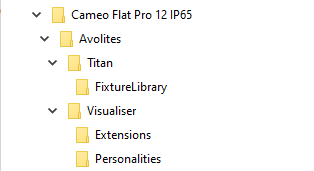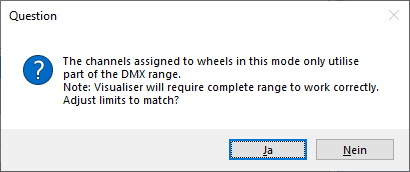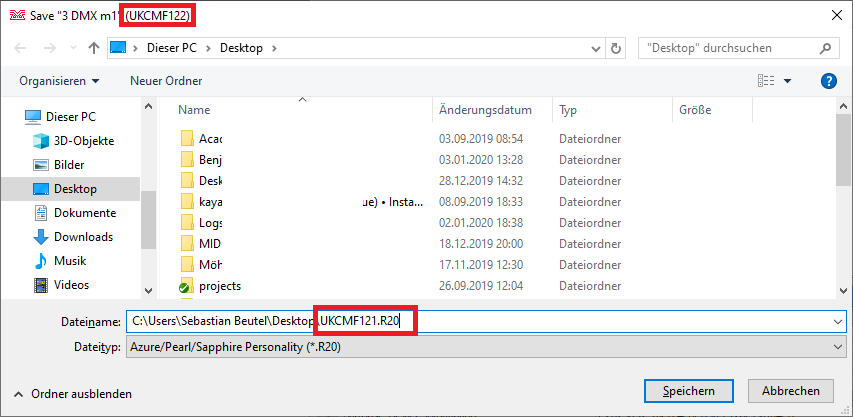This is an old revision of the document!
Table of Contents
Creating vis files from d4 personalities
(This is NOT an official documentation but simply based on my personal experiences - it might be not complete or even simply wrong in some aspects. Please give feeback if you find anything what you think should be improved.)
Even though the old visualiser is now superseded by Capture it might be useful for some - and as personalities for the visualiser are not made any more, here are some hints how you can make them from d4 Titan personalities.
A pre-requisite is of course an up-to-date manual or at least DMX chart of the fixture you want to do files for.
1. Check if there really doesn't exist one
Use the search on https://personalities.avolites.com/ to check if there really doesn't exist what you need - downloading is always faster than attempting to do yourself.
2. Update your personality library
You certainly do not want to work with old data. Thus, download and install the latest Titan Fixture Library from https://personalities.avolites.com/.
3. Prepare a skeleton folder structure
This process will produce a couple of files which all need to go to designated folders. It has proven to be useful to have such a folder structure while preparing vis personalities:
My Fixture
// You may put the manual/DMX-Chart here //
Avolites
Titan
FixtureLibrary
Visualiser
Personalities
Extensions
Example:
4. Identify the correct d4 file
We assume that a d4 personality for your fixture already exists. Luckily they usually have verbose file names - have a look in the personality folder (with the PC suite installed it is C:\Program Files (x86)\Avolites\Titan\FixtureLibrary). If you don't find what you need then search at https://personalities.avolites.com/ or https://www.avolites.de/downloads/d4find for the correct filename. If you still don't find anything then request the personality for Titan or build it yourself (this might be explained on another day).
If you have found the correct d4 file copy it to \Avolites\Titan\FixtureLibrary in the folder structure.
Now, our example looks like this:
CAMEO FLAT PRO 12 IP65
│ CLPFLATPRO12IP65_Cameo_Bedienungsanleitung_EN_DE_FR_ES.pdf
│ CLPFLATPRO12IP65_Cameo_DMX_Control_table.pdf
│
└───Avolites
├───Titan
│ └───FixtureLibrary
│ Cameo_FLAT PRO 12 IP65 (CLPFLATPRO12IP65).d4
│
└───Visualiser
├───Extensions
└───Personalities
Then doubleclick the d4 file to open it in the Titan Personality Builder.
5. Create/check Pearl references
In the personality builder expand the modes section (left panel). One by one click on each mode and check that there is a setting in the Classic Pearl Reference field bottom right. This makes the reference from Titan to the visualiser.
If there is no entry then you need to make one yourself:
- albeit max. 11 characters yre allowed you make your life easier if you use max. 8 characters
- no spaces, no special characters, no umlauts, no symbols - just characters and numbers
- a good habit:
- start with two characters denoting the manufacturer (i.e. “RO” for Robe, “UK” for Unknown etc.)
- four to five characters for the fixture name
- one or two characters for the mode
- each reference must be distinct
Here it is already set as UKCMF125 which could be derived from
- UK as Unknown (this was where Cameo was listed previously)
- CM from Cameo
- F12 is a very brief abbreviation for
Flat Pro12 - 5 denotes mode 5
If you need (or want) to make your own entries then please check if a similar file (with an .R20 extension) already exists in C:\Program Files (x86)\Avolites\Visualiser\Personalities. If it does then use another reference. Again, each reference needs to be unique.
If you have changed anything then don't forget to save it with Save from the Files menu.
6. Generate R20 (and Vis) files
Now let's Personality Builder do its magic to prepare the files – it will most likely need our help for this though 
From the File menu select Generate R20 Files…
The next prompt asks if you want to create Visualiser files as well. Confirm this with Yes.
Now, one by one, Personality Builder scans each mode. For each mode, two files are created: an .R20 file (like he classic pearl files) and a vis file which is the actual visualiser personality. However, things usually don't go that smoothly.
The next prompt asks where the file should be saved - usually we can just confirm this (the filenam is created from our unique reference…):
Next, depending from the d4 file some prompts may be shown, e.g.
The channels assigned to wheels in this mode only utilise part of the DMX range. Note: Visualiser will require complete range to work correctly. Adjust limits to match?
Usually I select No here as we will check and correct the vis file manually anyway.
Another such prompt:
Fixture name is too long. Please shorten it by 11 character(s): .....
Here, you need to comply - shorten the given fixture name as only 11 characters can be displayed in the visualiser. This needs to be done per mode - it's a good idea to use something like 'm1', 'm2' or such to distinguish the modes. Here, I set the given name to FLAT PRO 12 m1.
Now the next mode is parsed and checked. Again we get the prompt asking for the filename. This time it really needs to be checked and corrected as it again suggest the name derived from mode 1. Change the filename for the one which refers to the reference of mode 2 (as suggested in the prompt's title bar):
Here it again suggests the filename UKCMF121.R20 - however, the title bar tells that we have to change this to UKCMF122.R20.
Proceed with this until all modes have been processed. Eventually, 2 files per mode will be created. Here, as all five modes have references and are exported, 10 files will be created:
Move all .R20 files to the folder Avolites\Visualiser\Personalities and all .VIS files to the folder Avolites\Visualiser\Extensions
of your folder skeleton. In our example the result looks like this:
CAMEO FLAT PRO 12 IP65
│ CLPFLATPRO12IP65_Cameo_Bedienungsanleitung_EN_DE_FR_ES.pdf
│ CLPFLATPRO12IP65_Cameo_DMX_Control_table.pdf
│
└───Avolites
├───Titan
│ └───FixtureLibrary
│ Cameo_FLAT PRO 12 IP65 (CLPFLATPRO12IP65).d4
│
└───Visualiser
├───Extensions
│ UKCMF121.VIS
│ UKCMF122.VIS
│ UKCMF123.VIS
│ UKCMF124.VIS
│ UKCMF125.VIS
│
└───Personalities
UKCMF121.R20
UKCMF122.R20
UKCMF123.R20
UKCMF124.R20
UKCMF125.R20
7. Edit R20 files
Usually the R20 files - originally personalities for the Classic consoles - do not need to be edited. I had a coupld of times where I needed to do this in the past in order to make the visualiser working properly. If I come across such a fixture again I will add this to this section.
Editing R20 files is done with a standard text editor. Make sure the editor really works with plain ASCII text without interfering with the character set, encoding or whatsoever. For starters, Windows Editor (a.k.a. Notepad) does work. Personally I prefer Notepad++ - but there are many such programs available.
Most of the syntax is explained in the file itself. Only as a reference, here is a screenshot of such a file opened in Notepad++.
8. Edit vis files
Unlike the R20 files, the VIS files essentially always need to be edited before the fixture really works in the Visualiser.
Editing vis files is again done with a text editor (my recommendation: Notepad++ as mentioned above). The settings are explained in chapter 10, 'Visualiser Definitions', of the Visualiser Manual, from page 38 on. This is a MUST READ.












